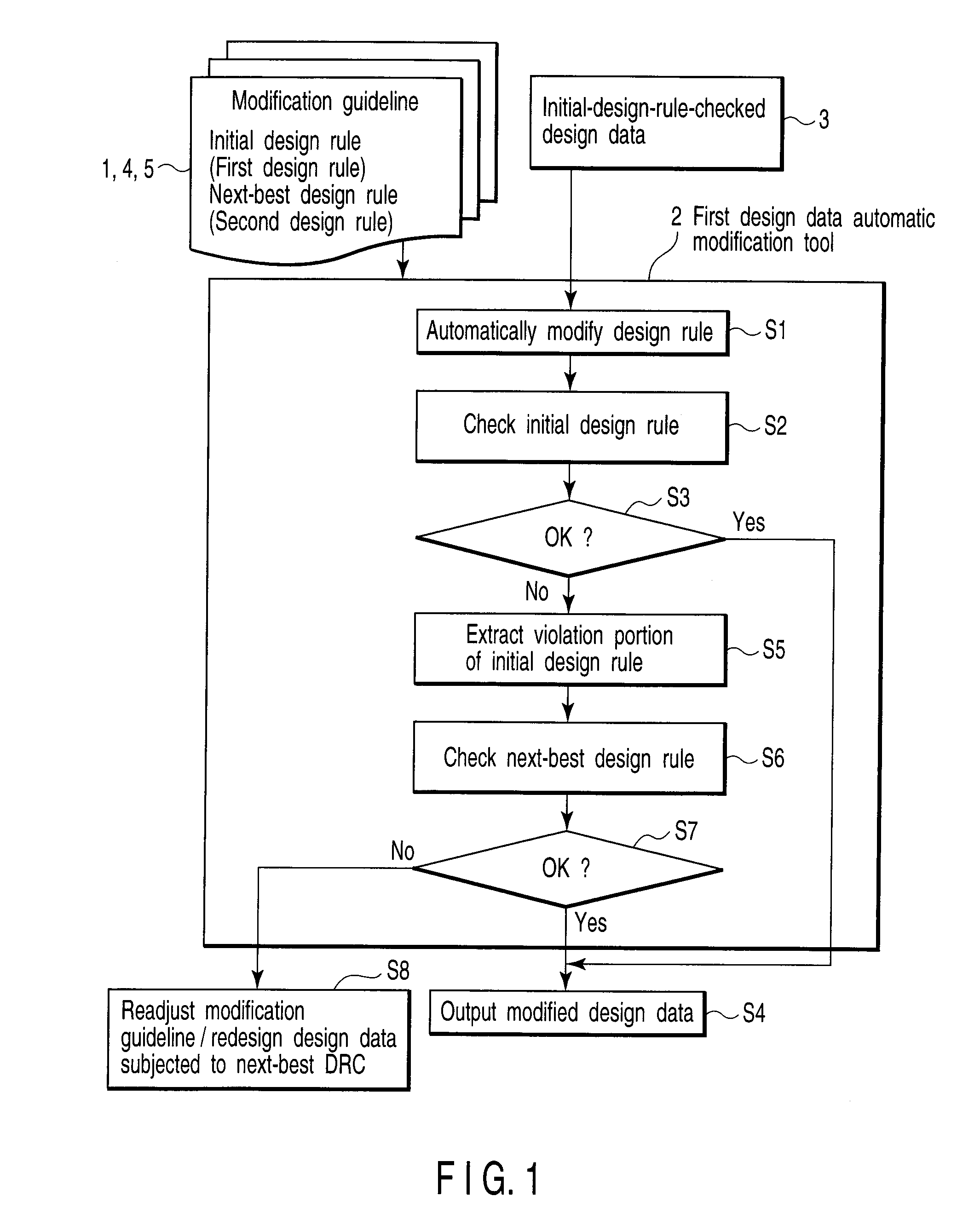Pattern forming method and pattern verifying method
a technology of pattern and forming method, applied in the direction of computer aided design, program control, instruments, etc., can solve the problems of inability to detect the danger of pattern and layout being modified by an unnecessarily large amount of modification, and inability to verify whether input design data is correctly modified on the basis of a guidelin
- Summary
- Abstract
- Description
- Claims
- Application Information
AI Technical Summary
Problems solved by technology
Method used
Image
Examples
first embodiment
[0024]A first embodiment according to the present invention will be described below with reference to FIGS. 1 and 2. In the first embodiment, the following technique will be described. That is, when a process dangerous portion of a pattern is automatically modified prior to actual formation of the pattern to be formed in a semiconductor device, the propriety of design data at the portion modified while partially outstripping a design rule is automatically checked without a manual operation to make it possible to efficiently check the modified portion. Accordingly, a technique which can easily create design data of a proper pattern including a modification which partially outstrips a design rule will be also described below.
[0025]A pattern forming method according to the embodiment will be described below with reference to a dangerous portion modifying flow according to the embodiment shown in FIG. 1.
[0026]As shown in FIG. 1, prior to execution of a pattern forming method according t...
second embodiment
[0071]A second embodiment according to the present invention will be described below with reference to FIGS. 3, 4, and 5. The same reference numerals as in the first embodiment denote the same parts in the second embodiment, and a description thereof will be omitted.
[0072]In the embodiment, in addition to the first and second design rules used in the first embodiment, a third design rule is used. The second embodiment will be described below in detail.
[0073]A pattern forming method according to the embodiment will be described below with reference to a dangerous portion modifying flow shown in FIG. 3. The pattern forming method according to the embodiment modifies the dangerous portion in conformity with a design rule, depending on the necessity of the design rule.
[0074]As shown in FIG. 3, prior to execution of the pattern forming method according to the embodiment, an initial design rule 1, design data 3 which is subjected to first design rule check by the initial design rule 1 and...
third embodiment
[0115]A third embodiment according to the present invention will be described below with reference to FIGS. 6, 7A, 7B, 7C, 8A, 8B, 9, and 10. The same reference numerals as in the first and second embodiments denote the same parts in the third embodiment, and a detailed description thereof will be omitted.
[0116]The embodiment relates to a technique that efficiently and easily forms an optimum design pattern on semiconductor manufacturing process parameters given in advance and, in particular, to a technique that verifies the propriety of a method of modifying an automatically modified pattern or layout and can improve the quality of design data of the pattern or the layout. The embodiment will be concretely described below in detail.
[0117]First, a pattern forming / verifying method according to the embodiment will be described below with reference to a flow of a verifying system for automatically modified design data shown in FIG. 6 and FIGS. 7A, 7B, 7C, 8A, and 8B. The pattern formin...
PUM
 Login to View More
Login to View More Abstract
Description
Claims
Application Information
 Login to View More
Login to View More - R&D
- Intellectual Property
- Life Sciences
- Materials
- Tech Scout
- Unparalleled Data Quality
- Higher Quality Content
- 60% Fewer Hallucinations
Browse by: Latest US Patents, China's latest patents, Technical Efficacy Thesaurus, Application Domain, Technology Topic, Popular Technical Reports.
© 2025 PatSnap. All rights reserved.Legal|Privacy policy|Modern Slavery Act Transparency Statement|Sitemap|About US| Contact US: help@patsnap.com



